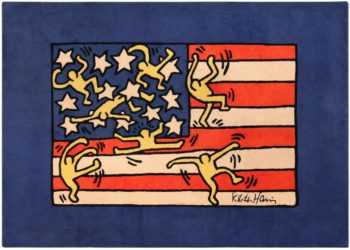Keith Haring
View our current collection of Keith Haring Rugs and Tapestries below:
“Born In The USA” Vintage Art Rug By Keith Haring 71771
$8,800.00Size: 7 ft 10 in x 5 ft 8 in (2.39 m x 1.73 m)
Learn More About Tapestries and Rugs by Artist Keith Haring
View our entire collection of art rugs and carpets by famous artists
Using his unique artistic talent, Keith Haring became a voice for social change. His publicly accessible graffiti style art spoke to the masses and changed the traditional perception of art. From subway walls to printed clothing and art rugs, today, Haring’s designs are accessible to a world-wide community.
Keith Haring’s talent started to emerge at a very young age, and he found his niche as a young adult. The free spirited New York City of the late 1970’s helped transcend his art into a voice of the unheard masses. Being fully immersed, he became uninhibited and true to himself and the vibe of the culture.
Initially, Haring created graffiti style art in the subway and walls along the streets of New York City. As his popularity and following grew, Keith developed a counter culture voice expressing and shinning a light on political and social issues of the time.
Communicating through the use of semiotic symbols as well as geometric lines and shapes, his tribal images transcended far beyond the barriers of language. The colorful expressions brought awareness to the HIV / AIDS epidemic of the 1980’s without the support of critics and curators.
Through his direct and unfiltered contact with the people, in many ways, Keith Haring changed the traditional channels and avenues of artistic success.
With his growing popularity, his art became more and more expensive. But Haring wanted his art to remain accessible for the everyday person. He was not and did not want to be or be perceived as an elitist.
It was important for Keith to remain true to his heart and soul and retain a strong focus on the voice of the people. This grounded approach lead him to open the downtown Manhattan “Pop Shop” in n 1986. The Pop Shop was a way for Haring to keep a huge body of his work accessible to the public and was, in his view, an extension of his more expensive art works.
The walls of the Pop Shop were covered with his murals and the shelves were filled with affordable “commercial” lines of clothing and gift items all featuring his unique icons. Sadly, this wonderful shop finally closed its doors in 2005.
Some have argued that Pop Shop was a commercial sell-out. But most agree that the venue allowed the public to attain Haring’s art through lower price points and easy access.
The accessibility of Haring’s art through textiles and licensing made the renderings truly public. By incorporating the art into tee shirts, backpacks and other everyday products, Keith felt he was giving all of the art to the community and the people rather than keeping it for himself.
The global licensing continues to keep his art alive, even though the Pop Shop closed in 2005.
Today, the Keith Haring Foundation still curates all of the artist’s images and hold the copyrights thus maintaining true to the intentions of the artist. In addition to managing the licensing, the foundation fosters creative education for children by encouraging hands-on lessons that Haring would appreciate.
Ultimately changing and transforming the idea of art, Keith Haring was an ego-less creator who focused on the greater good. His world wide exhibitions and continued popularity serve to remind us that we, each and ever one of us, are only limited by our own fears and self imposed doubts.

